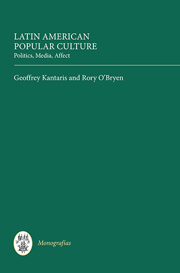Book contents
- Frontmatter
- Contents
- List of Illustrations
- Notes on Contributors
- Acknowledgements
- Introduction: The Fragile Contemporaneity of the Popular
- I Politics
- 1 ‘And where are the people?’ Genealogies of the pueblo during the Late Eighteenth and Early Nineteenth Centuries
- 2 Folktales and Fabulation in Lucrecia Martel's Films
- 3 How Popular is Cuban Popular Culture?
- 4 ‘El convertible no convertible’: Reconsidering Refuse and Disjecta Aesthetics in Contemporary Cuban Art
- II Media
- III Affect
- Index
4 - ‘El convertible no convertible’: Reconsidering Refuse and Disjecta Aesthetics in Contemporary Cuban Art
from I - Politics
Published online by Cambridge University Press: 05 October 2013
- Frontmatter
- Contents
- List of Illustrations
- Notes on Contributors
- Acknowledgements
- Introduction: The Fragile Contemporaneity of the Popular
- I Politics
- 1 ‘And where are the people?’ Genealogies of the pueblo during the Late Eighteenth and Early Nineteenth Centuries
- 2 Folktales and Fabulation in Lucrecia Martel's Films
- 3 How Popular is Cuban Popular Culture?
- 4 ‘El convertible no convertible’: Reconsidering Refuse and Disjecta Aesthetics in Contemporary Cuban Art
- II Media
- III Affect
- Index
Summary
This chapter discusses the work of internationally acclaimed, influential mixed-and multimedia artists who may be situated between the introduction in the 1990s in Cuba of the policy that granted artists the right to receive payment in convertible currency as well as to promote their work abroad freely, the introduction of a parallel currency for foreign visitors and investors (peso cubano convertible) and the ironic taking stock of the effects that such liberalization and commerce had on visual art practice referenced by the exhibition Cubanos convertibles in 2008. Its reflections play on the slippage between ‘convertible’ currency and convertible vehicles in relation to the value assigned to convertibility in aesthetic and cultural paradigms. These artists' deconstructivist strategies have sought to critique globalization while dismantling the complicitous ‘impurities’ and incongruities of their own productivity, seen through the distorting mirror of frustrated consumerism at home and the voracity of the free market paragons abroad that promote and consume their wares. The twisted skein of the analysis aims to discuss an interestingly impersonal (although archival) reflexive trend in contemporary art that, fibred by notions of social responsibility, participatory spectatorship and dissent, has explored the notion of ‘recycling’ as broadly inclusive of material disjecta with attendant ideas of ingestion and reconversion. Pieces have been predicated on the shift of emphasis from the phenomenology of ‘beholding’ to the involvement of the public as recipient, correspondent, interlocutor or user, with attention focused on the body of the observer and on experience.
- Type
- Chapter
- Information
- Latin American Popular CulturePolitics, Media, Affect, pp. 109 - 138Publisher: Boydell & BrewerPrint publication year: 2013

